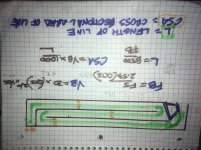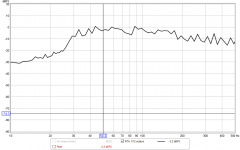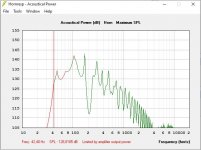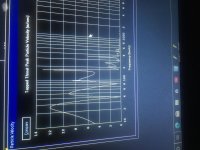Hi, it is very hard to follow what you are trying to say. Are you saying that a ROAR or a paraflex enclosure can be folded so that it minimizes (or maximizes?) room influense? Maybe a topic of another thread. Surely ROAR hornresp group delay graph is all over the place Martinsson's Blog - ROAR family overview so the idea looks like a mess. But since we have rooms messing up the sound anyway, this messiness could be benefitical, excite it all as much as possible which is the point with multisub systems. Anyone got any measurements? For the topic, bass reflex is a safe bet.
A paraflex will stir up room modes like no other qw pipe(TL) i have ever experienced. As will a ROAR, but in another way
Thank you for your great industriousness, meticulousness and hard work you are putting into advancing the Paraflex and ROAR and other high order QW designs and concepts!
I am following your work with great interest, even though I might not post much in your threads.
I prefer to push simplicity as far as I can possible can (fighting ME/CFS since 22 years and counting, so I might have 30 minutes of "uptime" a good day to do anything useful. This makes simplicity and easy to build designs a very important and time/energy-saving concept for me) so I really appreciate your advancements and experiments with much more complex and interesting designs. 🙂
Regards,
Johannes
Put simply - Why is the wast majority of the low frequency designs offered bass reflex?
The simple answer IMO is that high power amplification is easier to achieve than it used to be. Basically all of the other pro-BR points are dependent in one way or another on that one data point.
My favourite alignment as the moment BTW is the Offset-Driver Transmission Line. All the benefits of BR and more in a box that's only slightly bigger, and the internal panels serve to brace the box as well, which, along with the driver offset cleaning up the low midbass frequency wobbles, results in a wider and better overall passband with less power compression.
The simple answer IMO is that high power amplification is easier to achieve than it used to be. Basically all of the other pro-BR points are dependent in one way or another on that one data point.
My favourite alignment as the moment BTW is the Offset-Driver Transmission Line. All the benefits of BR and more in a box that's only slightly bigger, and the internal panels serve to brace the box as well, which, along with the driver offset cleaning up the low midbass frequency wobbles, results in a wider and better overall passband with less power compression.
Apply this exact idea to one extra ‘function’ and we can (together) find a way to use paraflex and ROAR and THAM passion and possibilities as the simple reality its only offset. everything is an offset. To which degree or amount then concentrating or distributing harmonics as constructive or destructive.
Once defined as specific locations we can taylor offset or not offset to folded sections of standing waves, including the 1/4 of Fundamental were typically cutting short the moment we begin. a direct radiator is not ideal unless its making Qes and Vas happy in some way. Often the OD/OE sim suites the most bandwidth, but theres another!
And its easier! Or ‘as easy’? I cant judge anyones needs, but heres a simple version. Or the door to moar after establishing a base plane (OD).
120 cm L12, 120 cm L23, 80 Cm L34, 0.01cm L45. TH, set CSA per your qw pipe maths(pic). the exit details are to each his own ‘path’ to learn. its safe to say we could agree to assume its not a big deal if we want to ? This looks an OD TL sim with no path, but its just a bit of damping away im guessing? Check it out? I tend to overlook details in rain bows. ‘Rain’ being hidden in the bright and shiny colors and fun.
I need to shut up and not derail the topic. Sorry, thankyou all for the collective knowledge and access to it on your websites! Its a leap frog for everyone trying to share your joy 🙂
Attachments
Last edited:
Hi, it is very hard to follow what you are trying to say. Are you saying that a ROAR or a paraflex enclosure can be folded so that it minimizes (or maximizes?) room influense? Maybe a topic of another thread. Surely ROAR hornresp group delay graph is all over the place Martinsson's Blog - ROAR family overview so the idea looks like a mess. But since we have rooms messing up the sound anyway, this messiness could be benefitical, excite it all as much as possible which is the point with multisub systems. Anyone got any measurements? For the topic, bass reflex is a safe bet.
Yes, but we must look at good, bad snd even ugly to see beautiful. And thats not my idea of a good time if it offends anyones hard work. Critics will be defended or offensive. facts are only as accurate as the people who want to know them can hear. its an endless battle and ‘okay, maybe’ is likeky more productive than anything for EVERYONE in the long term as this very thread may well show we shoot our own foot in discrediting or over devaluing it as inaccurate as anyones work or ideas even if perfect, imperfect, or neither. Its WE, it always will be. ‘We’ are(is) a fact.😀 otherwise known as ‘all of us as a community of like minded interests of diverse solutions to the same exact want. Our sound made our way. 🙂
lets ignore bass reflex. only because of its peculiar popular and quick and easy so it is favored even if its ‘right’ or ‘wrong’, its a dead horse that will never die and never ever should. But its monopolizing on easy, not necessarily much else
Apply this exact idea to one extra ‘function’ and we can (together) find a way to use paraflex and ROAR and THAM passion and possibilities as the simple reality its only offset. everything is an offset. To which degree or amount then concentrating or distributing harmonics as constructive or destructive.
Except that the THAM and other "higher-order" alignments typically result in much bigger boxes for the same drivers, even if you're trying to aim for the same LF corner as a simple BR box using the same driver. They're useful if you're trying to get the most out of one driver, but now that power is so cheap, just buying another BR to achieve the same thing with better (subjective, I know) usable bandwidth is a pretty hard option to turn down.
BTW, I promised myself that I would do another BOXPLAN Excel workbook for one of those Paraflex designs while I'm on vacation. Any suggestions? There seem to be quite a few out there now.
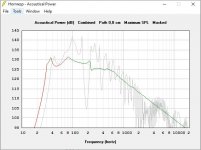
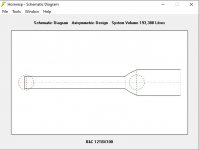
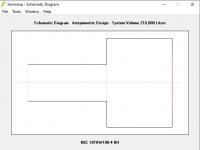
I gave the BR some extra system volume to counter the extra internal walls of the ROAR design.
I am sure someone can simulate a better BR, but here is a single B&C 12TBX100 in a ROAR12(ish) design with 2000 watts beating a more modern and powerful B&C 18TBW100 in a BR with 3000 watts available from the amp.
The BR is a little bit larger and goes almost 10 Hz lower in frequency, but the ROAR12 does have upward of 10 dB more output where it matters the most (midbass where some 50 to 80 % of the energy content of modern music is centered).
Due to the very physical and tactile reproduction of the ROAR12, it will not seem to lack much bottom end in a a/b comparison with this BR box.
This is not something that I can measure. It has to be experienced first hand, and those who has heard a high order QW know what I am talking about.
A 600 cm2 port where the air column is doing almost 35 m/s is not going to sound very musical or powerful. At these power levels we see lots of port compression and turbulence from the port, while the air velocity at the ROAR12 mouth peaks at 14 m/s.
Hi, it is very hard to follow what you are trying to say. Are you saying that a ROAR or a paraflex enclosure can be folded so that it minimizes (or maximizes?) room influense? Maybe a topic of another thread. Surely ROAR hornresp group delay graph is all over the place Martinsson's Blog - ROAR family overview so the idea looks like a mess. But since we have rooms messing up the sound anyway, this messiness could be benefitical, excite it all as much as possible which is the point with multisub systems. Anyone got any measurements? For the topic, bass reflex is a safe bet.
Except that the THAM and other "higher-order" alignments typically result in much bigger boxes for the same drivers, even if you're trying to aim for the same LF corner as a simple BR box using the same driver. They're useful if you're trying to get the most out of one driver, but now that power is so cheap, just buying another BR to achieve the same thing with better (subjective, I know) usable bandwidth is a pretty hard option to turn down.
BTW, I promised myself that I would do another BOXPLAN Excel workbook for one of those Paraflex designs while I'm on vacation. Any suggestions? There seem to be quite a few out there now.
If we use ROAR csa distribution in Ckassic Pflex, we get a HF bias where ROAR can create a midrange bulge. i had to fight away the thinking negative to see anything. so ditch ‘group delay’, size, or negatives, and we learn a ton! Most of all the group delay and ripples or weird things fade as you narrow it back to simple folded segments ON harmonic lengths of the Fb. (Imcluding the compounded abbreviated, etc. paraflex will get short and skinny disproportionate to less loud if not trying to go ‘lower’. roar wants a big CSA change to affectively create that transformer and low pass filter at a ‘shared amount’? i skew both roar and parafkex to long and thin air masses in segments instead of huge and wide(a lot of parallax used to be, or the weird idea that ‘exp’ flare can sum 3 or 4 folds of parabolic chunks and average out fairly to a midrange or lower result that's ‘real’! I dunno, but when in doubt, simple!
That common and cheap chinese car audio driver (skar) will do anything if you give it 200cm2 to its cone on one side. from there its scaled in anyway you can imagine and in ROAR i dont run out of wOW until iver made 2x the intial path of the tap entries even as the segmented expand yields a stepping of LF filters to create confidence in the standing wave material seen or not seen.
If i use your math i get 190cm2 at 190cm lomg (qw pipe). I think red LE makes me nervous. The false Qes hints at lower tuning maybe? in TL talk thst a 0.66 Qes instead of 0.33. Thstll make me wanna taper down and go below Fs vs the other.
But you gotta look to know thats happening(manually) so imduvtabce scares me and semi inductance might not help parFkex. its a very high tuned bias. not the false LE narrative we all are comcerned with (and the 18ds115 can be very red LE in reality in parafkex??.
LE and bass reflex get along better than almost anything else... we are all at a disadvantage on that alone?
an easy ROAR and Paraflex shape is the same. just move L45 to a mirror.
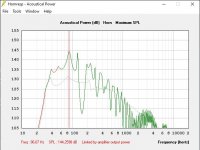
And if you are not afraid of buying an extra sheet of plywood (or two) to build a 600 liter ROAR18, then you can get some truly spectacular performance from a single 18TBW100.
Both the BR and the ROAR has the same driver and the same 3000 watt.
I set the xmax to 18 mm in the ROAR max spl graph since the ROAR design holds the cone really hard at high spl. I can´t get my 12PS100 to exceed xmax with 2000 watts even though Hornresp simulates 20 mm cone excursion. I have never been able to get a driver to exceed xmax in a ROAR, despite "5000 watt class D car amps" and similar excessive abuses. The voice coil does smell burned and we have been able to melt the glue between the magnets in a
car audio driver, but never pushed the driver beyond xmax.
Hi, it is very hard to follow what you are trying to say. Are you saying that a ROAR or a paraflex enclosure can be folded so that it minimizes (or maximizes?) room influense? Maybe a topic of another thread. Surely ROAR hornresp group delay graph is all over the place Martinsson's Blog - ROAR family overview so the idea looks like a mess. But since we have rooms messing up the sound anyway, this messiness could be benefitical, excite it all as much as possible which is the point with multisub systems. Anyone got any measurements? For the topic, bass reflex is a safe bet.
Except that the THAM and other "higher-order" alignments typically result in much bigger boxes for the same drivers, even if you're trying to aim for the same LF corner as a simple BR box using the same driver. They're useful if you're trying to get the most out of one driver, but now that power is so cheap, just buying another BR to achieve the same thing with better (subjective, I know) usable bandwidth is a pretty hard option to turn down.
BTW, I promised myself that I would do another BOXPLAN Excel workbook for one of those Paraflex designs while I'm on vacation. Any suggestions? There seem to be quite a few out there now.
If we use ROAR csa distribution in Ckassic Pflex, we get a HF bias where ROAR can create a midrange bulge. i had to fight away the thinking negative to see anything. so ditch ‘group delay’, size, or negatives, and we learn a ton! Most of all the group delay and ripples or weird things fade as you narrow it back to simple folded segments ON harmonic lengths of the Fb. (Imcluding the compounded abbreviated, etc. paraflex will get short and skinny disproportionate to less loud if not trying to go ‘lower’. roar wants a big CSA change to affectively create that transformer and low pass filter at a ‘shared amount’? i skew both roar and parafkex to long and thin air masses in segments instead of huge and wide(a lot of parallax used to be, or the weird idea that ‘exp’ flare can sum 3 or 4 folds of parabolic chunks and average out fairly to a midrange or lower result that's ‘real’! I dunno, but when in doubt, simple!
That common and cheap chinese car audio driver (skar) will do anything if you give it 200cm2 to its cone on one side. from there its scaled in anyway you can imagine and in ROAR i dont run out of wOW until iver made 2x the intial path of the tap entries even as the segmented expand yields a stepping of LF filters to create confidence in the standing wave material seen or not seen.
If i use your math i get 190cm2 at 190cm lomg (qw pipe). I think red LE makes me nervous. The false Qes hints at lower tuning maybe? in TL talk thst a 0.66 Qes instead of 0.33. Thstll make me wanna taper down and go below Fs vs the other.
But you gotta look to know thats happening(manually) so imduvtabce scares me and semi inductance might not help parFkex. its a very high tuned bias. not the false LE narrative we all are comcerned with (and the 18ds115 can be very red LE in reality in parafkex??.
LE and bass reflex get along better than almost anything else... we are all at a disadvantage on that alone?
an easy ROAR and Paraflex shape is the same. just move L45 to a mirror.
Except that the THAM and other "higher-order" alignments typically result in much bigger boxes for the same drivers, even if you're trying to aim for the same LF corner as a simple BR box using the same driver. They're useful if you're trying to get the most out of one driver, but now that power is so cheap, just buying another BR to achieve the same thing with better (subjective, I know) usable bandwidth is a pretty hard option to turn down.
BTW, I promised myself that I would do another BOXPLAN Excel workbook for one of those Paraflex designs while I'm on vacation. Any suggestions? There seem to be quite a few out there now.
We all agree on one thing: fun. the slow diminishing scale of fun has no boundary unless you must load it and unload it for free. if we entertain ‘comparisons’ the topic of fun is quickly gone. The best way to learn anything
Is to provide the wrong answer to the internet. Instant results and lots of them😀 hard to ones own ego, but easy to grab large quantities of quality detailed info. I have none of these things but i want the second.
Theres a paraflex for PA, and an end firing car audio or otherwise version.
At the end of the day i found (IMHO) something better that anyone from
Arizona(pflex) or sweden (roar) has created or tried to. It was fantastic and simple. But most of all It was both ! A unity of excellent ideas.
View attachment 905567
View attachment 905568
View attachment 905569
I gave the BR some extra system volume to counter the extra internal walls of the ROAR design.
I am sure someone can simulate a better BR, but here is a single B&C 12TBX100 in a ROAR12(ish) design with 2000 watts beating a more modern and powerful B&C 18TBW100 in a BR with 3000 watts available from the amp.
The BR is a little bit larger and goes almost 10 Hz lower in frequency, but the ROAR12 does have upward of 10 dB more output where it matters the most (midbass where some 50 to 80 % of the energy content of modern music is centered).
Due to the very physical and tactile reproduction of the ROAR12, it will not seem to lack much bottom end in a a/b comparison with this BR box.
This is not something that I can measure. It has to be experienced first hand, and those who has heard a high order QW know what I am talking about.
A 600 cm2 port where the air column is doing almost 35 m/s is not going to sound very musical or powerful. At these power levels we see lots of port compression and turbulence from the port, while the air velocity at the ROAR12 mouth peaks at 14 m/s.
What's the air velocity in the narrow part of the ROAR cabinet?
FWIW, going 10Hz lower is a Big Deal. While I agree the extra output is nice, I usually aim for 40Hz extension. All other things being equal (they're not, I know), a flat-to-40Hz system sounds much more impressive (and makes for happier customers) than a 50Hz system.
Chris
Yup. 10 Hz is the difference between a 40 Hz capable box and a 50 Hz capable box. Or a 30 Hz capable box and a 40 Hz capable box.
I do have both 40 Hz and 50 Hz capable boxes (POC3 and POC5). I once ran a simple contest between the two set to the same SPL level to a limited audience (my family), and they preferred the 40 Hz system, every single time, even when I played content with not that much content below 50 Hz. There was no hesitation in their choices either. And FWIW I thought the midbass integration of the 50Hz MLTL was noticeably better, but the overall choice went to the 40 Hz TH.
As a result, even though POC5 is capable of a little more linear output in its passband, it has never been used for any of my infrequent "mini DJ" outings. It spends most of its time being a stand for my other ongoing projects.
Maybe my next build will be a 40 Hz MLTL to get the best of both worlds.
And just a reminder, I did refer to boxes with 'the same LF corner' in my previous post. A comparison between two systems with a 10 Hz difference in the LF corner is not in compliance with my statement.
I do have both 40 Hz and 50 Hz capable boxes (POC3 and POC5). I once ran a simple contest between the two set to the same SPL level to a limited audience (my family), and they preferred the 40 Hz system, every single time, even when I played content with not that much content below 50 Hz. There was no hesitation in their choices either. And FWIW I thought the midbass integration of the 50Hz MLTL was noticeably better, but the overall choice went to the 40 Hz TH.
As a result, even though POC5 is capable of a little more linear output in its passband, it has never been used for any of my infrequent "mini DJ" outings. It spends most of its time being a stand for my other ongoing projects.
Maybe my next build will be a 40 Hz MLTL to get the best of both worlds.
And just a reminder, I did refer to boxes with 'the same LF corner' in my previous post. A comparison between two systems with a 10 Hz difference in the LF corner is not in compliance with my statement.
Theres one thing missing Brian and Chris. The slim possibility that the sound in the higher order is in fact different. Its not hard
to argue its tainted with imperfect and might be strange even?
but a dog food duct is proof theres much more than just the dog and pony show of making ‘great’. great, is tweeking some things using awkward methods in shape but very real and defined qw lengths... If we threw genius in a blender 5 times we get chaos. thats just a false narrative and a blanket or umbrella to a trillions active disasters. theres some thing in roar if theres something in dogfood duct or paraflex. It might be dog poop? But i think we should try and see instead of not? its nothing or its unique, right? look at phase at the exit in comparison to anything ? Paraflex wants 60 degrees and hit 90 before and after.. roar is another version of that but i haven't the proof to claim it, i burnt up some things and decided to try it i stead to see? i got side tracked when i saw the diversity in BOTH. As in together..
Edit: the air velocity in a high pressure zone is zero. But can we find a null in HR at zero? theres places to look but my drawings suck. And theyre not zero once we go to look🙁
to argue its tainted with imperfect and might be strange even?
but a dog food duct is proof theres much more than just the dog and pony show of making ‘great’. great, is tweeking some things using awkward methods in shape but very real and defined qw lengths... If we threw genius in a blender 5 times we get chaos. thats just a false narrative and a blanket or umbrella to a trillions active disasters. theres some thing in roar if theres something in dogfood duct or paraflex. It might be dog poop? But i think we should try and see instead of not? its nothing or its unique, right? look at phase at the exit in comparison to anything ? Paraflex wants 60 degrees and hit 90 before and after.. roar is another version of that but i haven't the proof to claim it, i burnt up some things and decided to try it i stead to see? i got side tracked when i saw the diversity in BOTH. As in together..
Edit: the air velocity in a high pressure zone is zero. But can we find a null in HR at zero? theres places to look but my drawings suck. And theyre not zero once we go to look🙁
Last edited:
The long & narrow part of the ROAR will have considerable air velocity - there's no way it's zero all the way along.
My question, then, is this: how much air velocity is there, and how much compression will result?
Brian,
I'm planning on taking that a step further and comparing 30Hz vs 40Hz. Got a design drawn up for the 30Hz box, and it's a big 'un...
Chris
My question, then, is this: how much air velocity is there, and how much compression will result?
Brian,
I'm planning on taking that a step further and comparing 30Hz vs 40Hz. Got a design drawn up for the 30Hz box, and it's a big 'un...
Chris
I suspect that a tune like The Weeknd's "Blinding Lights" will sound very different when played back on 40 Hz capable boxes when compared to 50 Hz boxes. Down to 30 Hz though? I'm not so sure. In car, being able to go down to 3 (!) Hz in my vehicle, it's awesome, but that's because at that point it can also do over 110 dB and we're down into the "God whispering" area.. 🙂
I'm sure that you will let us know how your test turns out....
I'm sure that you will let us know how your test turns out....
Attachments
The long & narrow part of the ROAR will have considerable air velocity - there's no way it's zero all the way along.
My question, then, is this: how much air velocity is there, and how much compression will result?
Brian,
I'm planning on taking that a step further and comparing 30Hz vs 40Hz. Got a design drawn up for the 30Hz box, and it's a big 'un...
Chris
For sure, but paraflex will split that into an expanded teo segment @ fold and the two combined is something nobody gives-a thought? So lets look 🙂
Roar will be fine, as will paraflex. Its a combined result of both that might prove most generic to scrutiny of issues that must be resolved in order to be advanced in mainstream? air velocity isn't worth defending as much as it is in showing its 12 m/sec at full boogie? We can accept and adjust things pointed out and together theres a mutual whats ‘okay’ if we are fair to all ideas 😀
Attachments
If it were up to me i would be abusing the freedom of chooseing what i might do, but thestepped expabd is a good compromise and acceptable?
Attachments
Last edited:
- Home
- Loudspeakers
- Subwoofers
- Design principle diversity below 100Hz in professional applications
